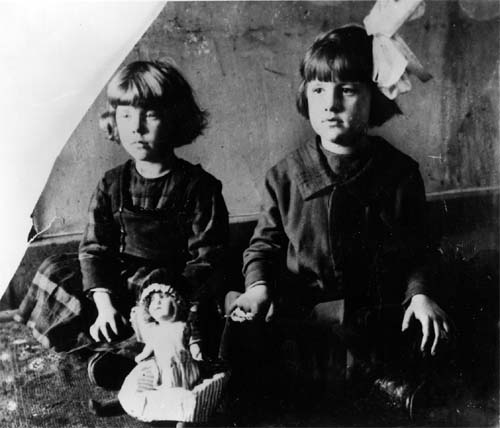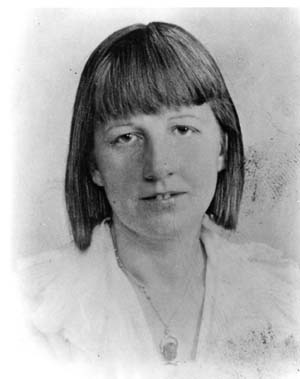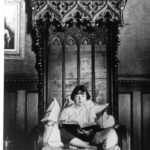
Birthdate: 08/26/08. Young’s childhood was both troubled and fantastic. Her mother and father separated when she was three, leaving Marguerite and a younger sister to be raised by her maternal grandmother, Marguerite Herron Knight, who nurtured Marguerite’s imagination and literary education. Marguerite’s mother, always absent, was said to be a beautiful women who had many husbands. Her father was a descendant of Brigham Young. The ancestry on her mother’s side was French Huguenot (William Sublette) as well as Scottish (John Knox). Marguerite’s grandmother became a stroke victim during Young’s adolescence, and both she and her sister bore the brunt of caring for an old woman who lived somewhere between life and death. In her grandmother’s “poetic and cosmic” semi-hallucinatory state she would speak of angels in the house and other unearthly creatures (Ruas, 1985, p.97). So it is no surprise that one of Young’s earliest poems, written at age 17, was dedicated to her grandmother.
At age 22, Young graduates from Butler University, Indiana with a BA in English and French in 1930, and publishes her poetry for the first time in Poetry: A Magazine of Verse, Vol. 36, edited by Harriet Monroe in Chicago. These first poems are “Ballad-Loving” (written about her grandmother), “Lot’s Wife,” “A Girl’s Song,” “Recurring.” In this same volume appear four poems of Marya Zaturensky, whose husband worked with Young on the journal Tiger’s Eye in the late 1940’s, started by her Chicago friends John and Ruth Stephan (heiress of the Walgreen Estate). Ruth Stephan (1910-1974), founder of the Poetry Centers in Tuscon, Arizona and Austin, Texas remained a life-long friend of Young’s. Young was invited to speak and recite her work for the 1966 Spring Reading Series at the University of Arizona Poetry Center. The audio of that presentation is archived here.
In 1936 Young receives her MA from the University of Chicago, having studied epic and Elizabethan and Jacobean literature with Robert Morrs Lovett, Ronald S. Crane, and T. V. Her thesis is about the birds and beasts of Euphues and His England. She lives for awhile in Shelbyville, Kentucky, where she writes poetry in the graveyards.
Young’s first volume of poetry, Prismatic Ground, is published in 1937 by the MacMillan Co., New York. If you have this volume of poetry, or find it in a used bookstore, hang onto it as it is very hard to find. Young continued to live in Indianapolis, teaching English at Shortridge High School. Having been invited by her mother and step-father to visit them in New Harmony, Indiana, where they owned a motion picture business, Marguerite became fascinated with the history of Utopian communities established there in the early 19th century. Young states in a 1985 interview (Ruas, 1985, p. 101) that she lived in New Harmony “for seven years off and on and gradually began to write about it.” Also see the account of this period in New Harmony in a 1988 interview done by Miriam Fuchs and Ellen Friedman, pp. 148-49. She begins her poetic history of two Utopian communities, the Rappites, and the Owenites, as a series of sixty ballads, and then converts this to blank verse, writing at night and teaching during the day.
Young’s memories of living in New Harmony and the historical details that she incorporated into her novels about the failed Utopian communities in Indiana were captured by WNYC Radio when Miss MacIntosh was first published. The presentation entitled “Writer Marguerite Young, Eccentric Documentarian of Utopias” is archived here.
Young studies for her doctorate in philosophy and English at the University of Iowa, and becomes a candidate in 1940. In 1941 she continues to work on her doctorate while teaching at Indiana University for the Indiana Writer’s Conference in addition to teaching at Shortridge High School. In 1942 she is awarded a lectureship in the department of English at the University of Iowa and receives a creative writing fellowship at the University’s Writer’s Workshop. One of her professors, Austin Warren, gives her name to a talent scout from Reynal & Hitchcock of New York, and in 1943 she submits to Mark Van Doren, an editor for Reynal & Hitchcock, manuscripts for a second volume of poetry, Moderate Fable (some of these poems had already been published in the Southern Review, 1942 Spring), and her final prose version of Angel in the Forest: A Fairy Tale of Two Utopias. Both manuscripts are accepted for publication. With the financial assistance of an AAUW Kathryn McHale Fellowship, Marguerite is able to move to New York City and finish her novel, hoping to make her living as a writer. She develops her prose style, and embraces the novel as the “epic of modernity” (Ruas, 1985, p. 103).
Young’s first work of fiction is published in 1943 in American Prefaces, a short story entitled “Dead Women” (reprinted in Inviting the Muses, 1994, by Dalkey Archive Press). Other work quickly follows. Young’s short story “Old James” is included in the 1944 collection of O. Henry Memorial Award Prize Stories (Garden City, NY: Doubleday). Moderate Fable is published in 1944, and wins the 1945 American Academy of Arts and Letters Award. That same year she also receives a National Institute of Arts and Letters Award. Her first work of prose, Angel in the Forest is published in 1945. She submits a draft of what will become Miss MacIntosh to Maxwell Perkins at Scribner’s, who had been Thomas Wolfe’s editor. She is given a contract for her first novel. In 1945 she co-edits with Henry Miller the Conscientious Objector. She is also one of the founding fiction editors for The Tiger’s Eye, and in 1947 selects for the journal’s first issue “The Sealed Room” by Anaïs Nin.
In the summers of 1946 (05/02-07/27) and 1947 (05/19-07/26) Young is invited to join the literary guests at Yaddo, an artists’ colony in Saratoga Springs, New York. There she meets Truman Capote and Carson McCullers in addition to Newton Arvin, Leo Lerman, Jerre Mangione, Agnes Smedley, Louise Talma, Ulysses Kay, Robert Lowell, and Theodore Roethke. In 1947 Burroughs Mitchell becomes the new editor of MMMD upon Maxwell Perkins’ death. Starting in the 40’s and 50’s and continuing through the 70’s, she reviews books and writes regularly for Flair, Vogue, Mademoiselle, The New York Times, New York Herald Tribune, the Chicago Sun, Washington Post Book World, Western Review, Literary Review, Nation, Harper’s Bazaar, New World Writing, the Kenyon Review, Partisan Review, Sewanee Review, New Directions, New York Times Book Review, and others.
In 1948 Young receives the Guggenheim Foundation award, and the Newberry Library award in 1951. In 1952 Young takes a break from the New York scene and travels to Rome, continuing her travels throughout England and the Continent for two years. She moves to Iowa upon her return in 1954, and receives a Rockefeller Foundation Fellowship to complete MMMD. She teaches at the University of Iowa Writers Workshop 1954-57, where she is teacher and mentor to John Gardner among many others. See David O. Dowling’s 2019 history A Delicate Aggression: Savagery and Survival in the Iowa Writer’s Workshop. Chapter 5, “The Guru: Marguerite Young” is an in-depth portrait of Young’s influence on emerging writers.
Young moves back to New York in 1958, and begins teaching at the New School of Social Research and Columbia University. For two years, 1960-62, she teaches at Fairleigh Dickenson while living in New York. From 1966-1977 she teaches periodically at Fordham University, and from 1971-77 she teaches periodically at Seton Hall University in New Jersey. From 1977-92 she teaches primarily at the New School of Social Research.
1965 is the first publication date of Miss MacIntosh, My Darling by Scribner’s. Angel in the Forest is reprinted by Scribner’s with an introduction by Mark Van Doren in 1966. Peter Owen in London publishes both Angel in the Forest, and Miss MacIntosh, My Darling (one volume), also in 1966. She becomes prominent in literary circles and is interviewed by radio personalities such as Duncan MacDonald, Matthew Paris, and Maurice Dolbier.
February 16, 1966 Young reads from her earliest ballads and Miss MacIntosh at the University of Arizona Poetry Center, Spring Reading Series. She talks to young writers about her life and the evolution of her vocation as a writer.
In 1966 Young continues with a writing project that she had begun before writing MMMD, a biography of Indiana poet, James Whitcomb Riley. As she does further research into his friendship with Eugene V. Debs, she decides to change the book’s focus to the life of Debs. She carries on for the next twenty-five years what eventually becomes a vast amount of research material on both historical figures.

The journal Under The Sign of Pisces, co-edited by Anaïs Nin, dedicates an issue to Marguerite Young in Fall of 1974. Charles Ruas writes a short review of MMMD for this issue; other contributors are Erika Duncan, Leslie B. Tanner, Richard Centing, Honey Rovit. The Diary of Anaïs Nin 1955-1966, published in 1976, includes references to Nin’s friendship with Young.
In 1974-1975 WBAI Radio broadcasts a series of programs called “The Reading Experiment” produced by Charles Ruas. Passages from MMMD are read aloud by Young’s contemporaries from the New York City literature, music, and theater communities. Also included in the radio series are interviews by Ruas with Anaïs Nin and Marguerite Young.
Before her death in 1977, Anaïs Nin persuaded Harcourt Brace Jovanovich to buy paperback rights to MMMD, and 10,000 copies are printed in 1979; Anaïs Nin also wrote the preface to this edition. In 1983 Young is celebrated in St. Louis at the annual meeting of the Associated Writing Programs (AWP) for a lifetime of achievement. At the conference she meets R. Eric Staley, whose account of his frustrated efforts to gather a renowned group of her literary peers and friends for a celebration of Young’s literary contributions is recounted in chapter one of his 1993 dissertation, “No Landscape but the Soul’s: A Critical Study of the Work of Marguerite Young.”

Young first asked Staley to help edit her Debs manuscript. She had always projected that the work would require three volumes, Vol. I entitled Prelude in the Golden Key: The Life and Times of Eugene Victor Debs, Vol. II Cloud Wreck, Water Wreck, Star Wreck, Earth Wreck, and Vol. III Harp Song for a Radical: The Life and Times of Eugene Victor Debs. However, she was never able to complete more than Volume One, which totaled 2,400 pages at this time. Staley was unable to take on the task, and Charles Ruas was hired in the fall of 1994 by Knopf Publishing to edit the manuscript. Young passed away in 1995, and Ruas continued to work on her manuscript of the Debs biography, entitled Harp Song for a Radical: The Life and Times of Eugene Victor Debs, which was published in fall of 1999.
In 1985, the 20th anniversary of MMMD‘s first publication, there is a renewed interest in Young’s work. Charles Ruas and Erika Duncan republish earlier interviews with Young. A 1989 issue of Dalkey Archive Press’ literary journal, the Review of Contemporary Fiction, Vol. 9, is devoted to Marguerite Young, Kathy Acker, and Christine Brooke-Rose. Dalkey Archive Press, with the guidance and enthusiasm of publisher Steven Moore, releases a new paperback edition of MMMD in 1993. A new edition of Angel in the Forest is published in August 1994. Also in 1994 Dalkey Press publishes Young’s collection of essays and short fiction, entitled Inviting the Muses: Stories/Essays/Reviews, in addition to a volume of tributes entitled Marguerite Young, Our Darling, edited by Miriam Fuchs, currently Professor of English, University of Hawaii. Miriam Fuchs and Ellen G. Friedman had earlier contributed their 1988 interview with Young to the 1989 Review of Contemporary Fiction tribute.
In 1992 Young’s friend Elinor Langer arranges for Young’s papers to be archived at the Yale Collection of American Literature, Beinecke Rare Book and Manuscript Library. The Young archive currently consists of approximately eighty-four uncatalogued boxes of material. In late 1992 Young submits the completed volume one of her Debs biography to Alfred A. Knopf Publishing House, and a contract is signed in January of 1993. In 1993 Young, in very ill health, moves back to Indianapolis where she is cared for by her niece until her death. Young’s final work consisted of constant revisions to the Debs manuscript (none of which were used in the final published version), and a return to her original medium of writing, poetry.
November 17, 1995 Marguerite Young dies at age 87. Respice finem.
“I bear a heavy gift”
Biographical information for Marguerite Young can be found in the following references:
Audio Recordings: May 1983 interview in New York City by Kay Bonetti and readings by Marguerite Young from Miss MacIntosh My Darling. Cassette Tapes. Archived at the State Historical Society of Missouri. Digitized copies of Young’s readings on this site.
World Authors, 1950-1970. Ed. J. Wakeman, 1584-86. NY: The W. H. Wilson Co., 1975.
Contemporary Authors, permanent series Vol. I. Ed. C. D. Kinsman, 694-95. Detroit: Gale Research, 1975.
Contemporary Authors, Vol. 150. Ed. K. Edgar, 483. Detroit: Gale Research, 1996.
American Women Writers, Vol. 4. Ed. Tina Mainiero, 488-89. NY: Frederick Ungar Publishing Co., 1982. Entry written by Lorene Pouncey.
Contemporary Novelists (1972, 1975 1982). Eds. J. Vinson, et. al. NY: Macmillan. Entries written by William Goyen.
Contemporary Literary Criticism, Vol. 82. 394-421. Detroit: Gale Research, Inc., 1994.
New York Times Obituary by Robert Mcg. Thomas Jr., November 20, 1995.
Writer’s Directory. St. James Press, 1994.


Leave a Reply